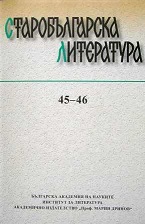Византийските синаксари и техните славянски реплики
The Byzantine Service Typika and Their Slavonic Replicae
Author(s): Iskra Hristova ShomovaSubject(s): Language and Literature Studies
Published by: Институт за литература - БАН
Summary/Abstract: The term Typikon and its meanings are discussed in the article and the difference between the Monastic and Service Typika is explained. The significant role of the Byzantine Lectionaries (Aprakos Gospels and Apostoloi) is discussed as well. Further, three Byzantine Service Typika are described: a) the Typikon of the Great Church, which was used in the parish liturgy in the 9th and partly in the 10th century; b) the Typikon of the Studion Monastery, which was used since the 10th century both in the monasteries and in the town churches; c) the Jerusalem Typikon, which became mandatory for the Greek churches from the 13th century. At first, the Lectionaries, especially the Aprakos Apostoloi, contained the Synaxaria of the Service Typika, so the Typikon of the Great Church and the Studion Typikon were preserved mainly in Apostoloi. Later, the Synaxaria of the Jerusalem Typikon were imbedded in Psalters. In the article some examples of the Slavic replicae of the Greek Typika are cited which prove that the Typikon of the Great Church was translated in the earliest age of the Slavic Christianity, most probably by the Holy Brothers Cyril and Methodios. The problem of the existence of a book called Tropologion in the early period in medieval Bulgaria is discussed in connection with the Studion Typikon and its use.
Journal: Старобългарска литература
- Issue Year: 2012
- Issue No: 45-46
- Page Range: 116-143
- Page Count: 28
- Language: Bulgarian
- Content File-PDF

